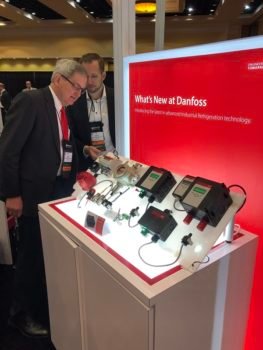
Another popular product Danfoss introduced at IIAR 2018 was the ICFD - ICF Defrost Module, which combines our leading liquid drain methods of hot gas defrosting with ICF technology, integrating two great approaches into one state-of-the-art solution that offers improved operational efficiency, easy installation, and energy savings.
The Danfoss complete range of fixed digital gas detectorssignaled the next generation of gas detection to all at the exhibition. These gas detectors range from basic to heavy duty models that utilize pre-calibrated digital sensors, on-board diagnostics, and digital life meters to match to your specific refrigerant, application, and safety requirements.
New to Danfoss’ industrial refrigeration portfolio, our IIAR 2018 booth showcased low voltage AC Drives with the support of our Drives division. The VLT Refrigeration Drive FC 103 offers efficiency- and reliability-enhancing features, integrated process control functions and a commissioning environment specifically designed to meet the needs of refrigeration applications. The NEMA 4X VLT AQUA Drive is suitable for installations that require protection against windblown dust, rain, or splashing water and can be installed directly at the equipment location without a protective enclosure.
Industrial Refrigeration Sales Director, Jim Hower led an information session detailing how our next generation digital gas detectors can reduce installation and maintenance costs while maximizing the safety of industrial refrigeration systems, titled Let Danfoss Recalibrate the Way You Look at Gas Detection for Industrial Refrigeration.
Niels Vestergaard, Industrial Refrigeration Global Application Excellence Manager, and Morten Juel Skovrup, Industrial Refrigeration Global Applications Excellence Manager, led a technical conference entitled Energy and Function Analysis of Hot Gas Defrost in Ammonia Refrigeration Systems.
The two presented data showing the significant impact that proper design requirements have on the efficiency of both Pressure Control and Liquid Drain defrost systems. They analyzed the relative efficiency of these two defrost system types, described how they quantified the energy consumption used in the two methods, and discussed the influence of operating conditions and evaporator design.